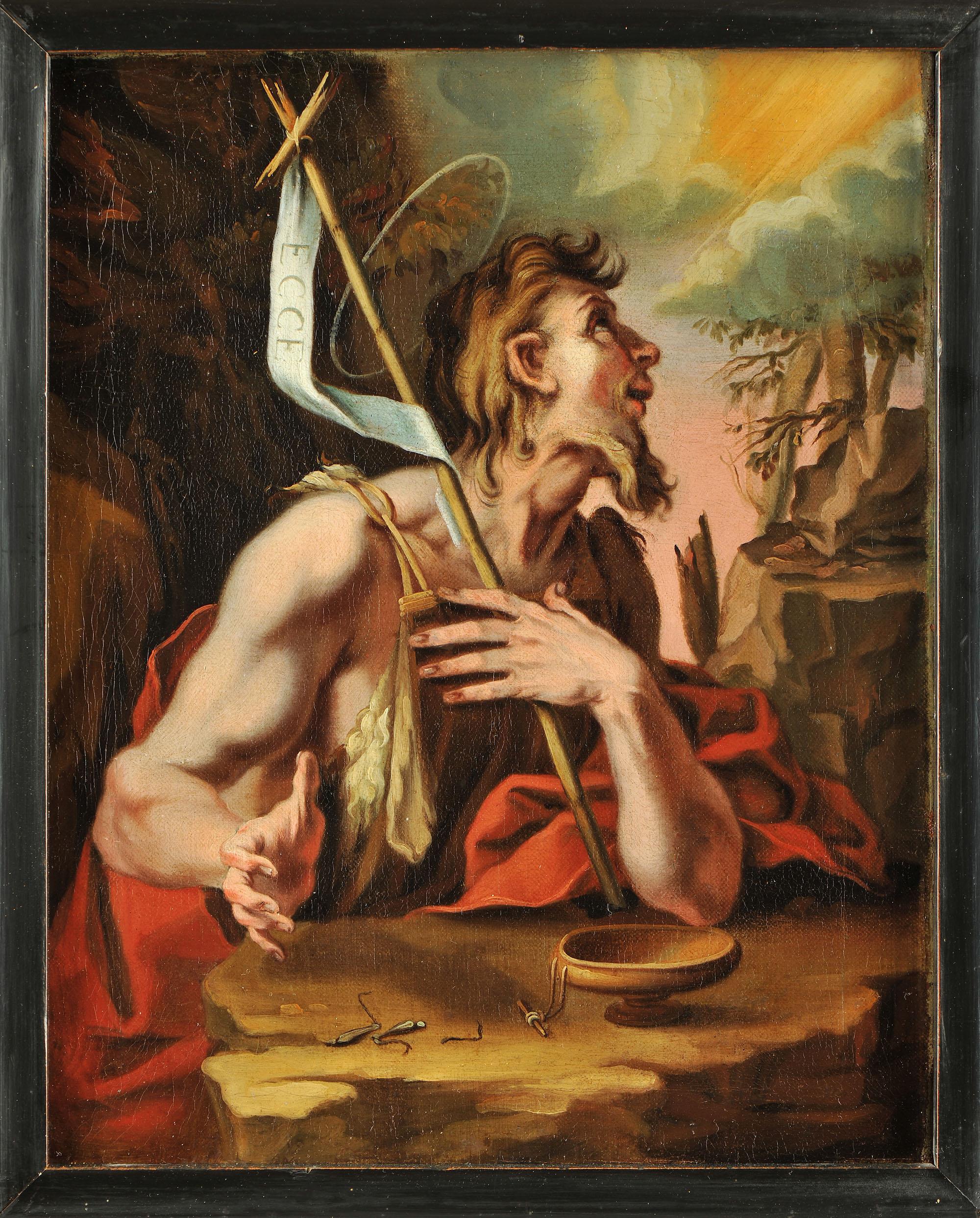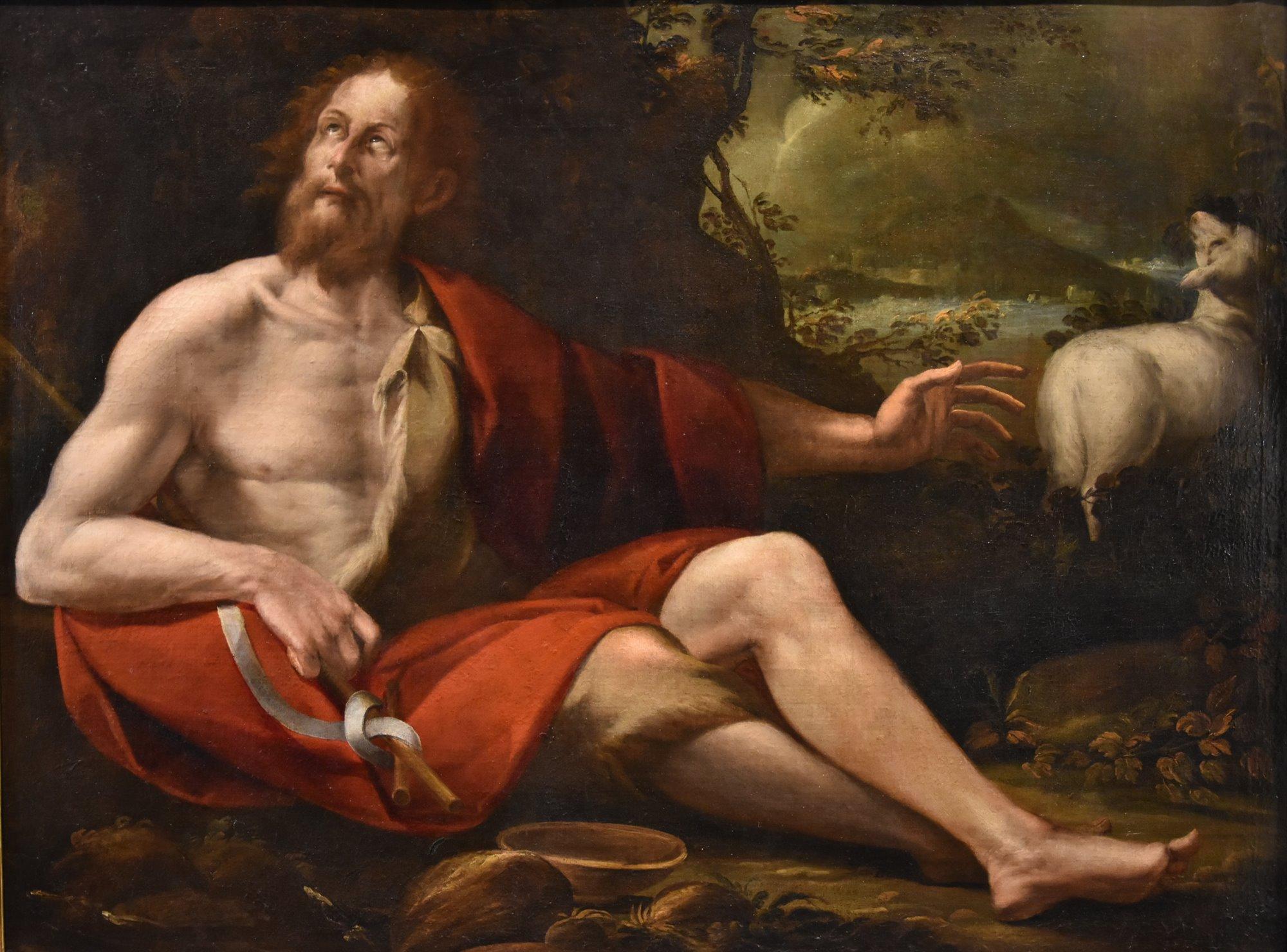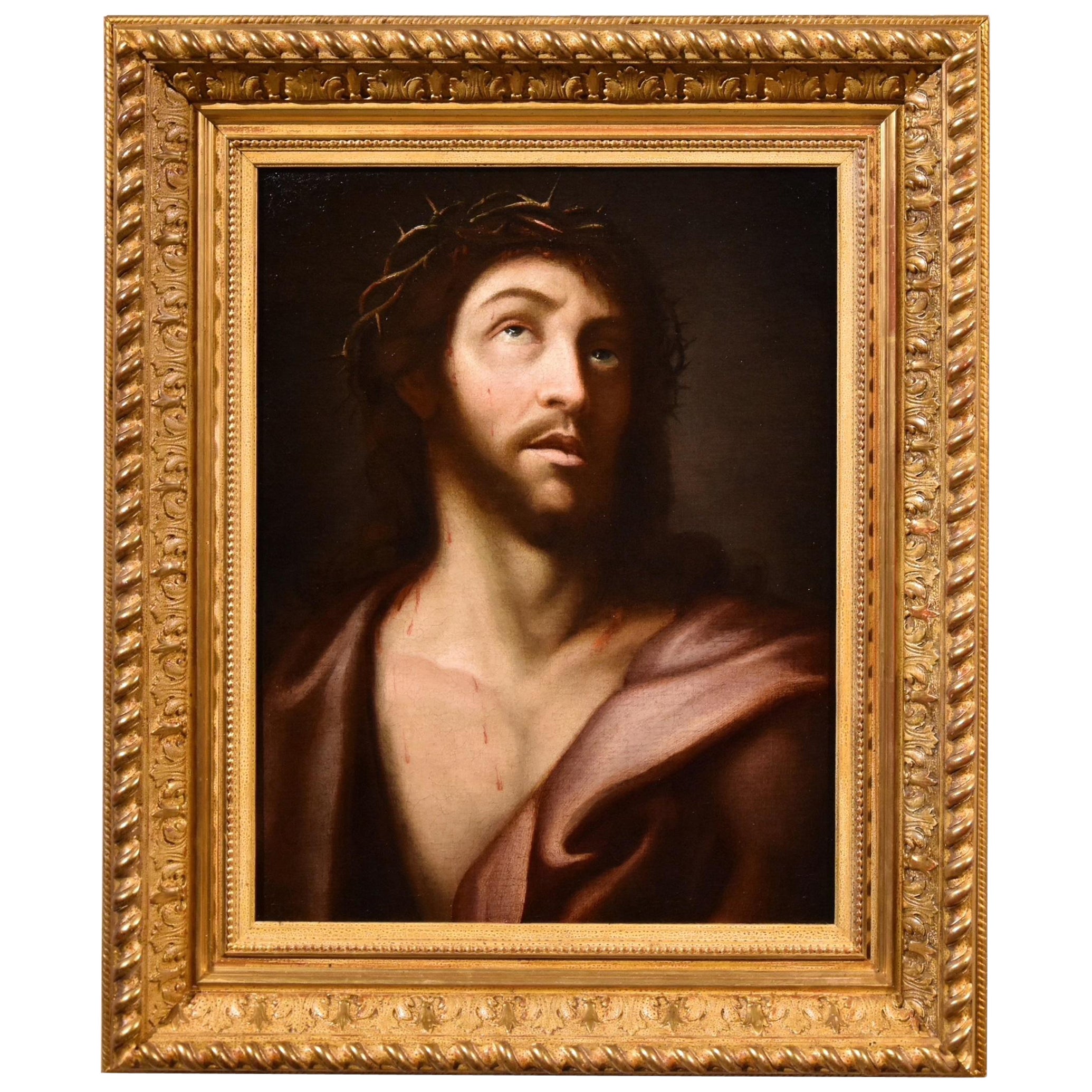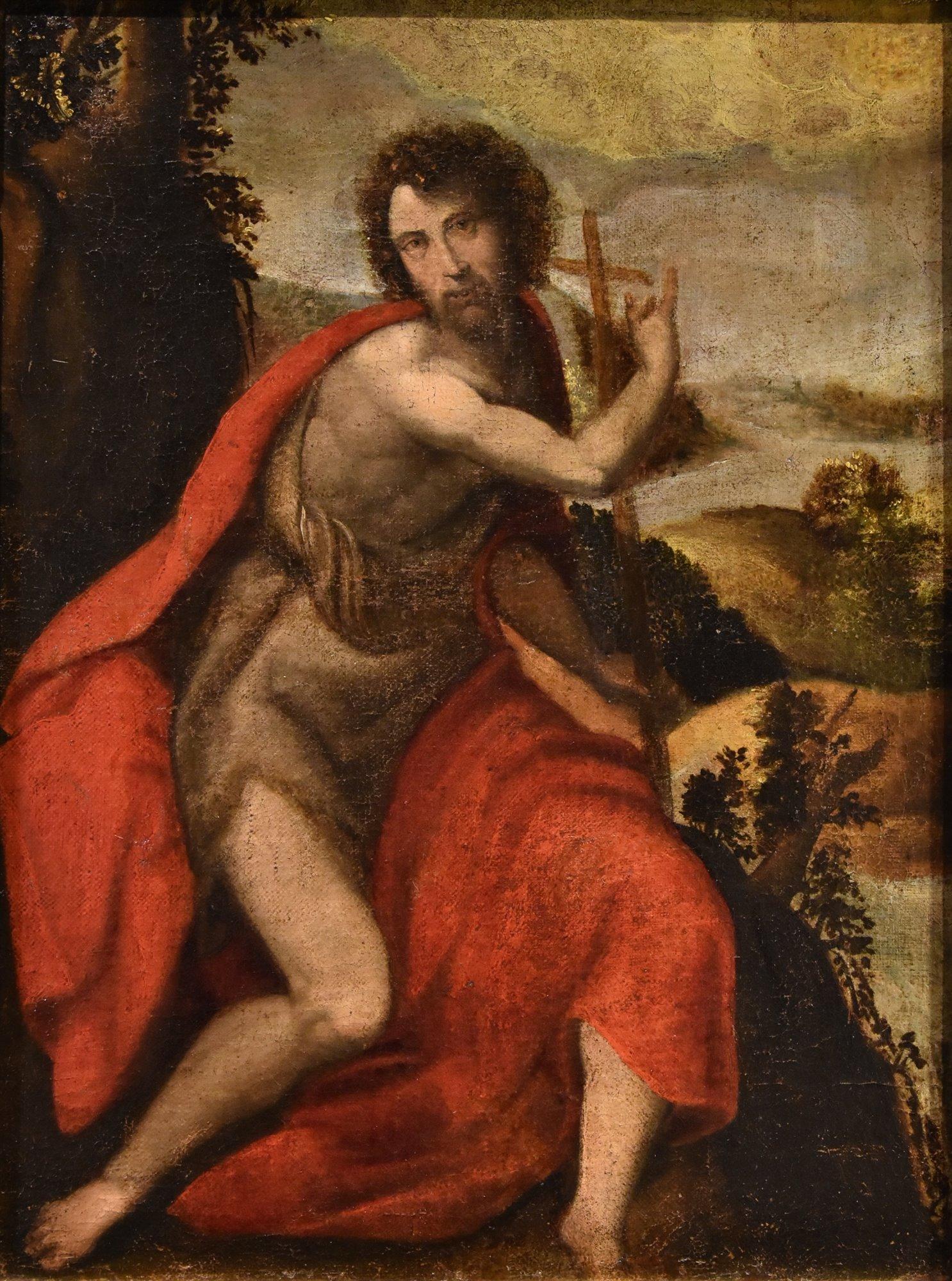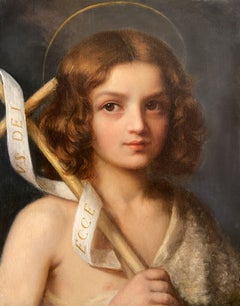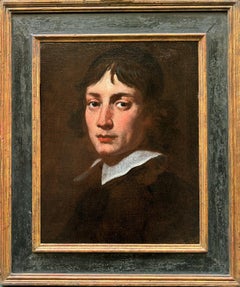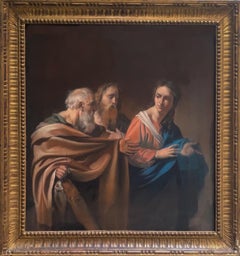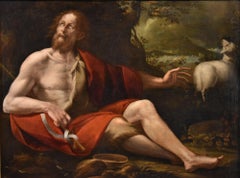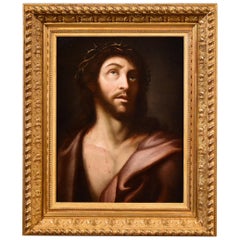Items Similar to John the Baptist
Want more images or videos?
Request additional images or videos from the seller
1 of 7
Francesco CurradiJohn the Baptist
$38,696.64
£28,500
€33,437.30
CA$54,237.41
A$58,911.65
CHF 31,188.80
MX$711,321.65
NOK 389,360.38
SEK 368,857.11
DKK 249,673.55
About the Item
Oil on canvas
Image size: 17 x 21 inches (43 x 53 cm)
18th Century Carlotta frame
Provenance
Private Country Estate
When depicting John the Baptist artists often added an outer garment of cloth, often in a red or orange toga-like arrangement. Here the artist has depicted John the Baptist clothed in robes of this type with the traditional attribute of the halo above John's head.
John gazes downwards wistfully with a soft and gentle expression conveying his emotional state.
Saint John's solemn pensiveness is reinforced by deep shadows that play across the body of the saint, with a bright light illuminating from above and to his right. Indeed, as John is lit strongly the bold contrasts between light and dark not only give dimension to John's features but also the subtle use of chiaroscuro employed by the artist brings a dramatic element to the composition.
The story of John the Baptist comes from the New Testament, particularly the gospels, and from Flavius Josephus's work, 'The Antiquities of the Jews'. After living an ascetic life in the desert, John emerged into the lower Jordan Valley preaching about the imminent arrival of God's judgement, and urging his followers to repent their sins and be baptised in preparation for the coming Messiah.
John the Baptist's preparatory message attracted thousands of followers to Jerusalem and Judea. Jesus came to John while he was baptising people in the River Jordan and asked to be baptised himself. John subsequently baptised Jesus in the River Jordan.
Francesco Curradi was born in Florence in 1570 son of the sculptor Taddeo Curradi. He is traditionally believed to have been a pupil of Giovanni Battista Naldini and graduated from the Accademia del Disegno in 1590. Curradi was one of the most sought-after painters of religious subjects in seventeenth century Florence: his works from the 1630s and 1640s present clear and uncomplicated compositions with a certain pious melancholy.
He played an important role in Florentine Seicento painting, fusing the ideology of the Counter Reformation with his own delicate decorative charm. A secure chronology for his work is, however, difficult to establish, for his mature style was established by 1620 and changed little after that.
- Creator:Francesco Curradi (1570 - 1661, Italian)
- Dimensions:Height: 17 in (43.18 cm)Width: 21 in (53.34 cm)
- More Editions & Sizes:17 x 21Price: $32,587
- Medium:
- Period:
- Condition:
- Gallery Location:London, GB
- Reference Number:1stDibs: LU52413971422
About the Seller
5.0
Vetted Professional Seller
Every seller passes strict standards for authenticity and reliability
Established in 2007
1stDibs seller since 2014
85 sales on 1stDibs
Typical response time: 3 hours
- ShippingRetrieving quote...Shipping from: London, United Kingdom
- Return Policy
Authenticity Guarantee
In the unlikely event there’s an issue with an item’s authenticity, contact us within 1 year for a full refund. DetailsMoney-Back Guarantee
If your item is not as described, is damaged in transit, or does not arrive, contact us within 7 days for a full refund. Details24-Hour Cancellation
You have a 24-hour grace period in which to reconsider your purchase, with no questions asked.Vetted Professional Sellers
Our world-class sellers must adhere to strict standards for service and quality, maintaining the integrity of our listings.Price-Match Guarantee
If you find that a seller listed the same item for a lower price elsewhere, we’ll match it.Trusted Global Delivery
Our best-in-class carrier network provides specialized shipping options worldwide, including custom delivery.More From This Seller
View AllChrist as a Boy
Located in London, GB
Attributed to Francesco Bonsignori
Italian 1455-1519
Christ as a Boy
Oil on wood panel
Image size: 12 1/4 x 16 inches (31 x 40.5 cm)
Original gilt frame
In this painting on panel, ...
Category
16th Century Italian School Portrait Paintings
Materials
Oil, Wood Panel
St John the Baptist as a Child, Early 19th Century Italian School, Oil Painting
Located in London, GB
Oil on canvas
Image size: 15 x 19 inches (38 x 48.25 cm)
Handmade gilt pierced frame
This is a beautiful early 19th Century Italian Old Master oil painting with the subject matter ...
Category
Early 19th Century Italian School Portrait Paintings
Materials
Canvas, Oil
Portrait of a Young Man
Located in London, GB
Oil on canvas
Image size: 13 x 16 1/2 inches (33 x 42 cm)
Contemporary style frame (Image below)
Provenance
Private European Collection
Darnley Fine Art offers this boldly brushed ...
Category
17th Century Portrait Paintings
Materials
Canvas, Oil
The Callings of Saints Peter and Andrew
Located in London, GB
The Callings of Saints Peter and Andrew
Robert Edge Pine
1730-1788
Chalk on paper, unsigned
Image size: 15 1/2 x 17 inches (39.5 x 43 cm)
Original frame
Here in Pine’s picture disp...
Category
18th Century English School Figurative Drawings and Watercolors
Materials
Paper, Chalk
Self Portrait, Oil on Oak Panel, English School, Handmade Frame
Located in London, GB
Oil on oak panel
Image size: 9 x 7 1/4 inches (23 x 18.5 cm)
Period style hand made frame
This is a self-portrait is most likely by a 17th century English...
Category
17th Century Portrait Paintings
Materials
Oak, Oil
Portrait of a Young Man
By (After) Rembrandt van Rijn
Located in London, GB
Pupil of Rembrandt
Portrait of a Young Man
17th Century
Oil on oak panel
Image size: 4 1/4 x 5 inches (11 x 13 cm)
Dutch ebonised frame
This small portrait is of a young man, staring inquisitively out towards the viewer. The realism of his appearance is striking, with great care taken in the depiction of the man’s features - for example, his full lips and the slight bump in the bridge of his nose. The man wears a rich burgundy doublet and a black cap and is adorned with gold accessories, indicating a degree of wealth - it is likely that this is a miniature portrait for a wealthy patron. The warm flesh tones of this painting and the intricate rendering of the man’s curly brown hair demonstrate the artistry of the painter, who has successfully captured the image of youth within his brushstrokes.
Rembrandt’s Pupils
Upon completing his artistic education, Rembrandt opened a studio and began to take students - the first of which were Gerrit Dou and Isaac Jouderville. The studio functioned as an art school, in which materials and guidance were provided - contrary to the studios of his peers, Rembrandt did not offer lodging to his pupils. The families of prospective pupils had to pay Rembrandt 100 guilders (enough for a house at the time) for this artistic education, and the profits from any works produced by pupils under Rembrandt would be paid to the master rather than kept by the student-artist - this contributed substantially to the master’s income.When taking on pupils, Rembrandt looked for those who could already paint, and guided their styles to reflect his. By choosing pupils who were somewhat experienced artists, Rembrandt had an array of painters that could be involved at any stage of assisting with the creation of his works - in this way, Rembrandt’s pupils often functioned as studio assistants as well. In order to perfect Rembrandt’s style, pupils would paint copies of their teacher’s works, sometimes adding their own distinct variations. They would use the same subjects and models as Rembrandt himself, and would accompany him on outdoor trips to paint nature and landscapes. The extensive copying and utilisation of same source materials has rendered Rembrandt’s work and the work of his pupils difficult to differentiate, even in the modern era.At least 50 pupils were taught by Rembrandt, with many continuing on to become his studio assistants. A few graduated into successful artists in their own right - for example, Govaert Flinck...
Category
17th Century Portrait Paintings
Materials
Oil, Oak, Panel
You May Also Like
Fenzoni, Painting AND preparatorial Drawing, John the Baptist, Italy Renaissance
By Ferrau Fenzoni
Located in Greven, DE
The painting and the preparatory drawing are offered together.
Provenance
Private collection, Germany, Trier, c. 1980- 2013
Saint John the Baptist
Brown ink and wash over red chalk on oatmeal paper
31 x 20.5 cm
Inscribed: „Ferrau Fenzonio da Faenza invt. esque … imp. da Fran. Villamena …“.
bears the collector's mark of Henry Scipio Reitlinger (1882-1950; Lugt 2274a) on a tiny label glued to the verso
On the reverse is a partial drawing of a Pieta, pricked for transfer.
Provenance
New York, Doyle, 14. October 2015, No. 6
The painting and the preparatory drawing resemble the composition of an engraving after Ferraù Fenzoni by Francesco Villamena. Drawing, engraving and painting are almost identical, except for minor differences. Even the measurements nearly correspond: painting (32 x 25,5 cm), drawing (30 x 20,5 cm), engraving (31,1 x 23,5 cm).
Dr. Guiseppe Scavizzi confirmed the attribution of the present panting to Fenzoni and he dates it to c. 1590.
The inscription on the drawing reads “Ferrau Fenzonio da Faenza invt. esque. . . imp. da Fran: Villamena . . .”. The engraving’s inscription also lists place and date “Ferra Fensionius inventor/F. Villamoena sculpsit Rome/Aspectu fruitur… antra puer/cum Privilegio… 1613”.
Interestingly, the engraving is not mirrored as it is in most printing processes. Painting, drawing and engraving are not reversed but the same. It is remarkable to note that there are further paintings by Fenzoni which were engraved in the same order and not reverted. They also show strong parallels regarding the compositions and the measurements (see for example “Deposition of Christ” ).
Ferraù Fenzoni was an Italian painter mainly active in Todi. He is also called Il Faenzone after his birthplace (Faenza). He apprenticed in Rome during the papacy of Gregory XIII and contributed to numerous fresco cycles under pope Sixtus V, such as the Loggia della Benedizioni in the Lateran Palace, the frescoes on the walls and vaults of the Scala Santa of the adjacent Basilica of San Giovanni in Laterano, and the decoration in the Sistine library. His expressive canvases straddle the styles of Mannerism and Baroque. In 1594, he moved to Todi. A “Last Judgement” by him is housed in the cathedral of Todi. He returned to Faenza in 1599, where he decorated chapels in the cathedral from 1612 to 1616. In 1622, he completed a “Deposition”, now in the local Pinacoteca. In 1640, Fenzoni was named “cavaliere dello speron d’oro” by Cardinal Colonna and, on 25th April 1634, he was nominated vicar and “castellano of Granarolo”.
Fenzoni‘s style is characterized by a mixture of the Mannerism of the Northern Netherlands and the Italian Baroque.
Saint John the Baptist, Old Master, 17th Century, By Fenzoni, Religious Scene, Rome Art...
Category
16th Century Mannerist Figurative Paintings
Materials
Canvas, Oil, Handmade Paper
Ferrau FenzoniFenzoni, Painting AND preparatorial Drawing, John the Baptist, Italy Renaissance, 1590
$28,330 Sale Price
25% Off
Saint John Baptist Pombioli Paint 17th Century Oil on canvas Old master Italy
Located in Riva del Garda, IT
Tomaso Pombioli (Crema, 1579 – Crema, 1636)
Saint John the Baptist
Oil on canvas 99 x 130 cm. In frame 120 x 152 cm.
Reference bibliography: M. Marubbi and C. Piastrella, L'...
Category
17th Century Old Masters Paintings
Materials
Oil
$16,573 Sale Price
20% Off
Saint John Baptist 16/17th Century Paint OIl on canvas Old master Tuscany school
Located in Riva del Garda, IT
Florentine painter, 16th-17th century
Saint John the Baptist
Oil on canvas 67 x 56 cm - In frame 98 x 83 cm
In bringing out the sculptural figure of this young Saint John the...
Category
17th Century Old Masters Paintings
Materials
Oil
$9,698 Sale Price
20% Off
Ecce Homo Christ Paint Oil on canvas 17th Century Old master Leonardo Italian
Located in Riva del Garda, IT
Lombard painter of the seventeenth century
Ecce Homo
Oil painting on canvas
56 x 43 cm. , framed 75 x 63 cm.
Provenance: Florence, Pandolfini, 5.10.2021, lot 209
The proposed canv...
Category
17th Century Old Masters Paintings
Materials
Oil
$5,892 Sale Price
20% Off
18th Century European Portrait of Saint John the Baptist as a Child.
Located in SANTA FE, NM
18th Century European Portrait of a Child Saint John the Baptist
Oil on Canvas
19 x 14 1/4 inches
This lovely and sensitively painting has been examined by a professional restorer w...
Category
18th Century Old Masters Figurative Paintings
Materials
Canvas, Oil
$7,600 Sale Price
20% Off
Saint John Baptist Venusti Paint 16th Century Oil on canvas Old master Italy Art
Located in Riva del Garda, IT
Marcello Venusti (Mazzo di Valtellina 1510 - Rome 1579) workshop/circle
Saint John the Baptist
Oil on canvas (65 x 50 cm. - In frame 74 x 58 cm.)
The work depicts Saint John...
Category
16th Century Old Masters Paintings
Materials
Oil
More Ways To Browse
John The Baptist
Oil Paint Royal Portraits
Old Paris Painting
Portrait King George
Portrait Of Two Women
Robert Daughters
Sir Anthony Van Dyck
17 Century Portraits
17th Century Man Portrait
African American Portrait Painting
Coronation Painting
Danse Macabre
Military Portrait Paintings
Native American Portraits
Painting Of African Woman
Woman Portrait Black Dress
1944 Portraits
Middle Temple
